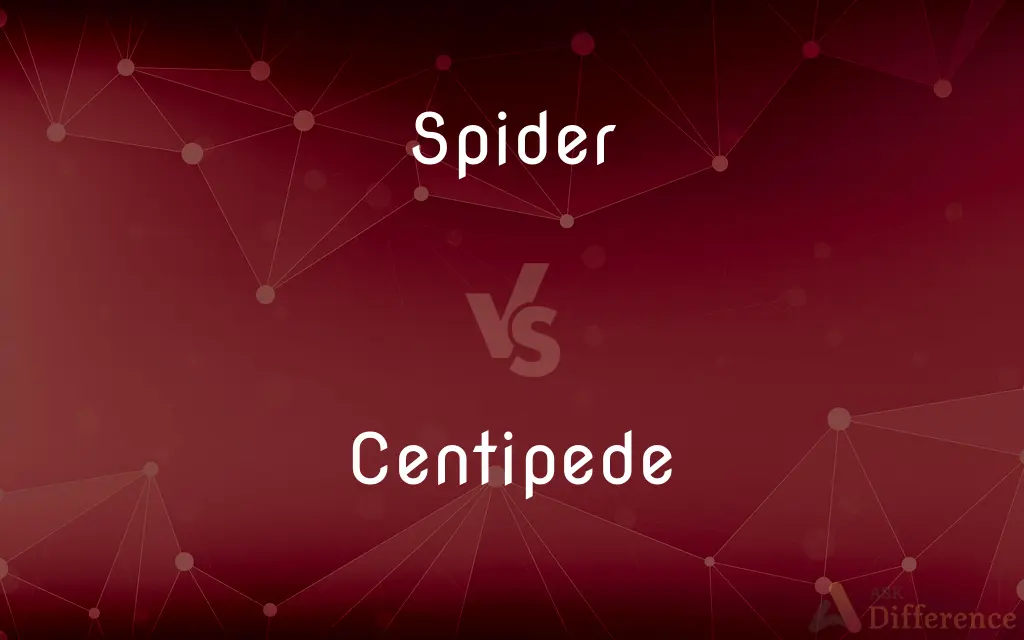Spider vs. Centipede — What's the Difference?
By Tayyaba Rehman — Updated on October 17, 2023
A Spider is an arachnid with eight legs and no wings, while a Centipede is a many-legged invertebrate with a flattened elongated body.

Difference Between Spider and Centipede
Table of Contents
ADVERTISEMENT
Key Differences
Spiders are part of the arachnid class, having eight legs and often spinning webs. In contrast, Centipedes belong to the class Chilopoda and have numerous legs, ranging from 30 to over 300 based on species.
Spiders are known for their ability to produce silk, which they use to create intricate webs to trap their prey. Centipedes, however, do not have this ability and hunt their prey, which often includes insects and spiders.
The body of a Spider is divided into two main parts: the cephalothorax and the abdomen. Centipedes, on the other hand, possess a more elongated body with numerous segments, each typically having one pair of legs.
Most Spiders are venomous and use their fangs to inject venom into their prey. Conversely, Centipedes have forcipules, a modified set of legs, to deliver venom to their victims.
Spiders generally prefer dry and warm places and can be found in various habitats worldwide. In contrast, Centipedes are more moisture-loving creatures and can often be seen in damp environments.
ADVERTISEMENT
Comparison Chart
Class
Arachnida
Chilopoda
Body Segments
Two: cephalothorax and abdomen
Numerous, each with one pair of legs
Leg Count
Eight
Ranges from 30 to over 300 based on species
Venom Delivery
Through fangs
Through forcipules
Preferred Habitat
Varies, but often dry and warm places
Damp environments
Compare with Definitions
Spider
An alcoholic drink made with brandy and lemonade or ginger beer.
Centipede
Prefers moist environments.
After the rain, the Centipede ventured out in search of food.
Spider
Known for web-spinning.
She watched as the Spider wrapped its prey in silk.
Centipede
A many-legged invertebrate.
The child was fascinated by the swift movement of the Centipede.
Spider
Possesses venomous fangs.
The Spider caught the fly and quickly immobilized it with venom.
Centipede
Part of the Chilopoda class.
Centipedes are distinguished from millipedes by their fewer legs and flatter bodies.
Spider
Can be solitary or social.
While most Spiders are loners, some species live in colonies.
Centipede
Has forcipules to deliver venom.
The Centipede uses its forcipules to catch and paralyze its prey.
Spider
Spiders (order Araneae) are air-breathing arthropods that have eight legs, chelicerae with fangs generally able to inject venom, and spinnerets that extrude silk. They are the largest order of arachnids and rank seventh in total species diversity among all orders of organisms.
Centipede
Centipedes (from the New Latin prefix centi-, "hundred", and the Latin word pes, pedis, "foot") are predatory arthropods belonging to the class Chilopoda (Ancient Greek χεῖλος, kheilos, lip, and New Latin suffix -poda, "foot", describing the forcipules) of the subphylum Myriapoda, an arthropod group which also includes millipedes and other multi-legged creatures. Centipedes are elongated metameric creatures with one pair of legs per body segment.
Spider
An eight-legged predatory arachnid with an unsegmented body consisting of a fused head and thorax and a rounded abdomen. Spiders have fangs which inject poison into their prey, and most kinds spin webs in which to capture insects.
Centipede
Any of various predatory arthropods of the class Chilopoda, having a long flattened body composed of segments, each bearing a pair of jointed appendages. The appendages of the foremost body segment are modified into venomous claws. Also called chilopod.
Spider
An object resembling a spider, especially one having numerous or prominent legs or radiating spokes.
Centipede
Any arthropod of class Chilopoda, which have a segmented body with one pair of legs per segment and from about 20 to 300 legs in total.
Spider
Another term for crawler (sense 2)
Centipede
A species of the Myriapoda; esp. the large, flattened, venomous kinds of the order Chilopoda, found in tropical climates. they are many-jointed, and have a great number of feet.
Spider
Move in a scuttling manner suggestive of a spider
A treecreeper spidered head first down the tree trunk
Centipede
Chiefly nocturnal predacious arthropod having a flattened body of 15 to 173 segments each with a pair of legs the foremost being modified into poison fangs
Spider
Another term for crawl (sense 4 of the verb)
When the search engines spider your site they'll find all of the pages
Centipede
Carnivorous and predatory.
The Centipede feeds on various insects, including Spiders.
Spider
Any of numerous arachnids of the order Araneae, having a body divided into a cephalothorax and an abdomen, eight legs, two chelicerae that bear venom glands, and two or more spinnerets that produce the silk used to make nests, cocoons, or webs for trapping insects.
Spider
One that resembles a spider, as in appearance, character, or movement.
Spider
A program that automatically retrieves webpages and follows the links on them to retrieve more webpages. Spiders are used by search engines to retrieve publicly accessible webpages for indexing, and they can also be used to check for links to webpages that no longer exist. Also called crawler, search bot.
Spider
New England, Upper Northern, & South Atlantic US See frying pan.
Spider
A trivet.
Spider
Any of various eight-legged, predatory arthropods, of the order Araneae, most of which spin webs to catch prey.
Spider
A program which follows links on the World Wide Web in order to gather information.
Spider
A float drink made by mixing ice-cream and a soda or fizzy drink (such as lemonade).
Spider
(slang) A spindly person.
Spider
(slang) A man who persistently approaches or accosts a woman in a public social setting, particularly in a bar.
Spider
A stick with a convex arch-shaped notched head used to support the cue when the cue ball is out of reach at normal extension; a bridge.
Spider
A cast-iron frying pan with three legs, once common in open-hearth cookery.
Spider
(cooking) Implement for moving food in and out of hot oil for deep frying, with a circular metal mesh attached to a long handle; a spider skimmer
Spider
(cycling) A part of a crank, to which the chainrings are attached.
Spider
Heroin.
Spider
(music) Part of a resonator instrument that transmits string vibrations from the bridge to a resonator cone at multiple points.
Spider
A skeleton or frame with radiating arms or members, often connected by crosspieces, such as a casting forming the hub and spokes to which the rim of a fly wheel or large gear is bolted; the body of a piston head; or a frame for strengthening a core or mould for a casting.
Spider
A soft-hackle fly.
Spider
(sports) The network of wires separating the areas of a dartboard.
Spider
(maths) A spider graph or spider tree.
Spider
(obsolete) A type of light phaeton.
Spider
(photography) A support for a camera tripod, preventing it from sliding.
Spider
(lawn bowls) A competition in which several participants are spread evenly around the edges of the green, who all make one bowl towards the central jack at the same time; the winner being the person whose bowl ends up closest to the jack.
Spider
To move like a spider.
Spider
To cover a surface like a cobweb.
Spider
To follow links on the World Wide Web in order to gather information.
The online dictionary is regularly spidered by search engines.
Spider
Any one of numerous species of arachnids comprising the order Araneina. Spiders have the mandibles converted into poison fangs, or falcers. The abdomen is large and not segmented, with two or three pairs of spinnerets near the end, by means of which they spin threads of silk to form cocoons, or nests, to protect their eggs and young. Many species spin also complex webs to entrap the insects upon which they prey. The eyes are usually eight in number (rarely six), and are situated on the back of the cephalothorax. See Illust. under Araneina.
Spider
Any one of various other arachnids resembling the true spiders, especially certain mites, as the red spider (see under Red).
Spider
An iron pan with a long handle, used as a kitchen utensil in frying food. Originally, it had long legs, and was used over coals on the hearth.
Spider
A trevet to support pans or pots over a fire.
Spider
A skeleton, or frame, having radiating arms or members, often connected by crosspieces; as, a casting forming the hub and spokes to which the rim of a fly wheel or large gear is bolted; the body of a piston head; a frame for strengthening a core or mold for a casting, etc.
Spider
Predatory arachnid that usually has silk-spinning organs at the back end of the body; they spin silk to make cocoons for eggs or traps for prey
Spider
A computer program that prowls the internet looking for publicly accessible resources that can be added to a database; the database can then be searched with a search engine
Spider
A skillet made of cast iron
Spider
An eight-legged arachnid.
The Spider spun a delicate web in the corner.
Spider
Found worldwide in various habitats.
Spiders thrive in both deserts and forests.
Common Curiosities
How many legs does a Centipede have?
Centipedes can have anywhere from 30 to over 300 legs, depending on the species.
Are Centipedes harmful to humans?
While some larger Centipedes can deliver a painful bite to humans, most are harmless.
How fast can a Centipede move?
Centipedes are swift movers, especially when hunting or evading predators.
Do Centipedes build webs like Spiders?
No, Centipedes do not produce silk and do not build webs.
Can Spiders be kept as pets?
Yes, some species, especially tarantulas, are kept as pets.
How do Spiders reproduce?
Spiders lay eggs, which they often encase in silk sacs for protection.
Can Spiders see well?
Spider vision varies, but many have poor eyesight and rely more on vibrations and touch.
Are all Spiders venomous?
Most Spiders have venom, but only a few species have venom harmful to humans.
What do Spiders typically eat?
Spiders primarily consume insects and other small creatures.
Do Spiders have wings?
No, Spiders do not have wings and cannot fly.
Are Centipedes and millipedes the same?
No, they are different; Centipedes are carnivorous with fewer legs, while millipedes are herbivorous with more legs.
Where are Centipedes commonly found?
Centipedes prefer damp environments and can be found under rocks, logs, or in soil.
Do all Spiders spin webs?
Not all Spiders spin webs; some hunt or ambush their prey without a web.
How do Centipedes defend themselves?
Centipedes use their speed, venom, and sometimes coloration to deter predators.
Are Spiders insects?
No, Spiders are arachnids, a separate class from insects.
Share Your Discovery

Previous Comparison
Jail vs. Prison
Next Comparison
Omeprazole vs. EsomeprazoleAuthor Spotlight
Written by
Tayyaba RehmanTayyaba Rehman is a distinguished writer, currently serving as a primary contributor to askdifference.com. As a researcher in semantics and etymology, Tayyaba's passion for the complexity of languages and their distinctions has found a perfect home on the platform. Tayyaba delves into the intricacies of language, distinguishing between commonly confused words and phrases, thereby providing clarity for readers worldwide.













































